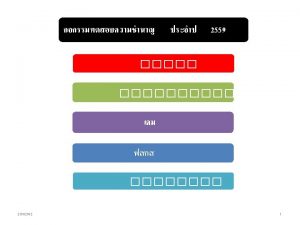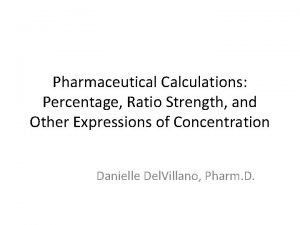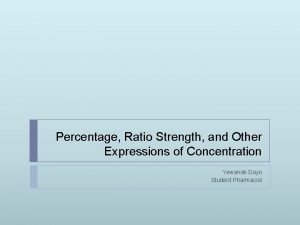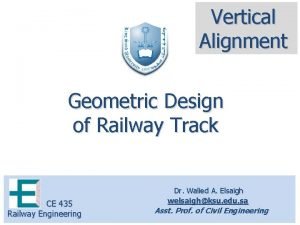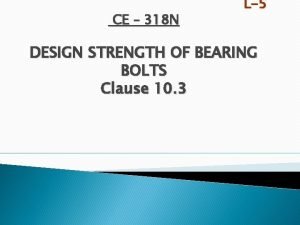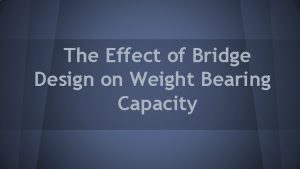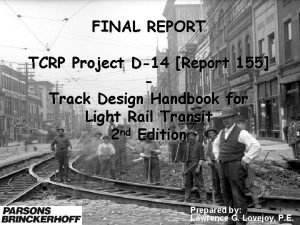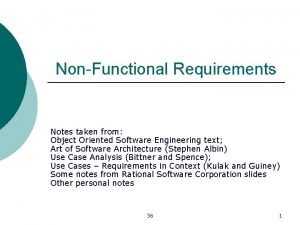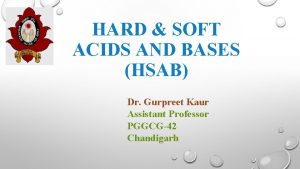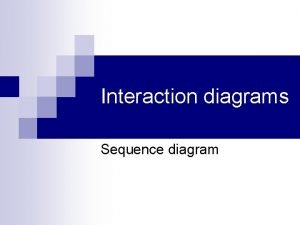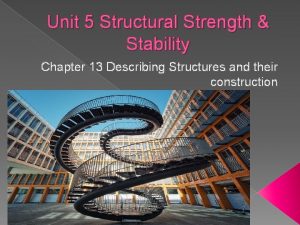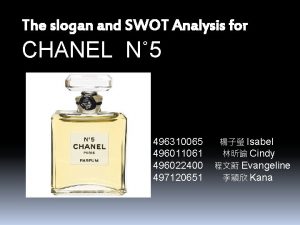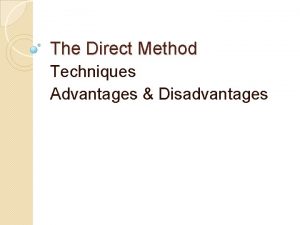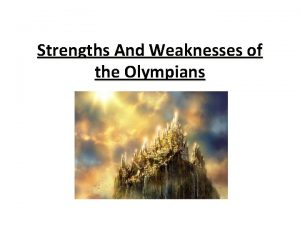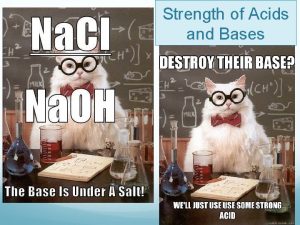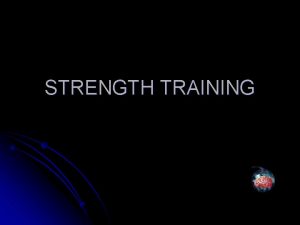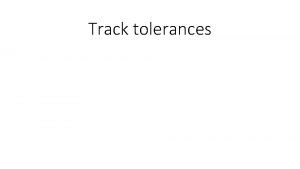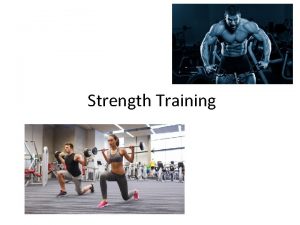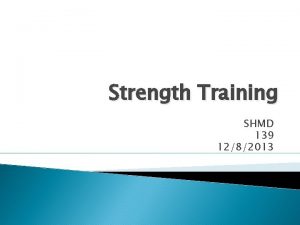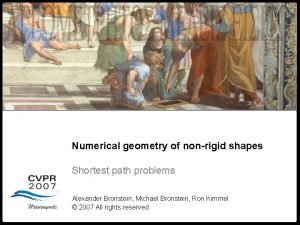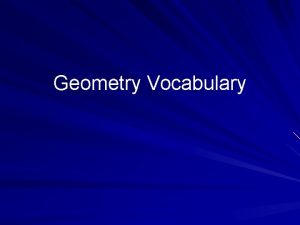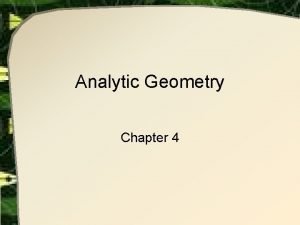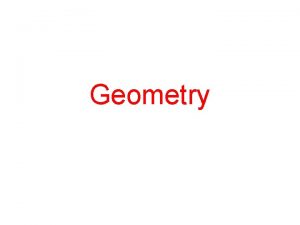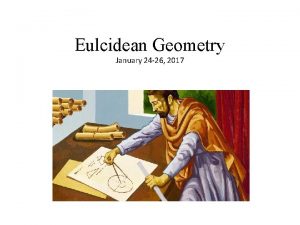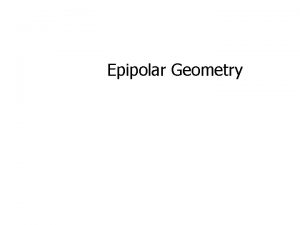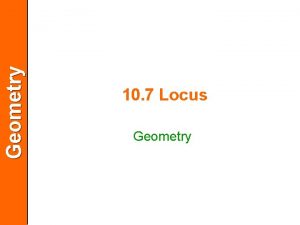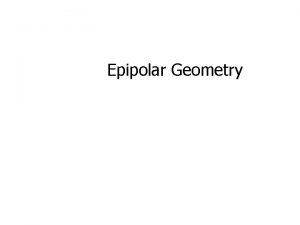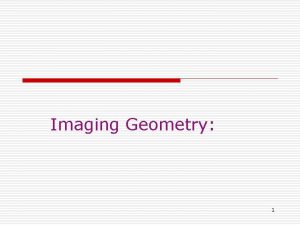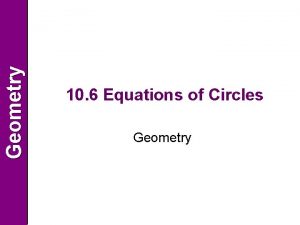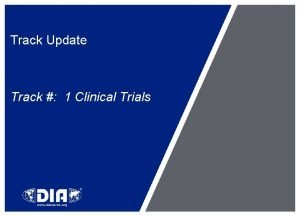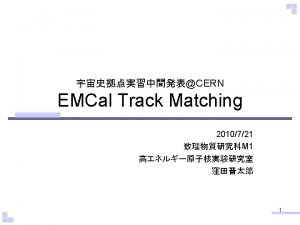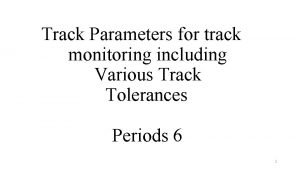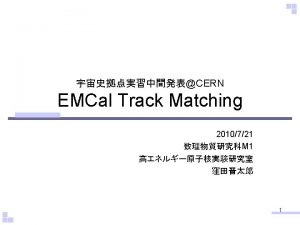TRACK STRENGTH AND TRACK GEOMETRY DESIGN REQUIREMENTS IF






























- Slides: 30

TRACK STRENGTH AND TRACK GEOMETRY DESIGN REQUIREMENTS IF HEAVY FREIGHT TRAFFIC HAS TO COEXIST WITH SEMI HIGH-SPEED PASSENGER TRAFFIC IPWE SEMINAR MUMBAI 2017 S. GOPALAKRISHNAN RETD. AGM / S. Rly & RETD. DIRECTOR / IRICEN EX. TECHNICAL ADVISER TRACK, GAMUDA ENGG, MALAYSIA 1

PREAMBLE Under the combination of heavy freight traffic and semi high-speed passenger traffic, track engineers’ concerns are: • Track deformation caused mainly by freight trains should not hinder passenger train requirements. • Track should remaintainable with reasonable efforts and at affordable cost Let us explore theoretical aspects underlying TRACK DETERIORATION or TRACK FATIGUE, which is required to be compensated by way of track maintenance effort, followed by few other issues specifically chosen by the Author. Solutions will also be explored side by side. 2

TOPIC 1 -TRACK DETERIORATION AS A WHEEL RUNS ON TRACK, THE INSTANTANEOUS WHEEL LOAD Q VARIES WITH RESPECT TO ITS STATIC VALUE QN. i. e. , Q MAY BE GREATER THAN OR LESS THAN QN INSTANTANEOUS WHEEL OVER-LOAD DECIDES THE TRACK DAMAGE. (ALSO WEAR & TEAR OF VEHICLE COMPONENTS – CONCERN OF MECH. ENGRS) THERE ARE TWO TYPES OF WHEEL OVERLOAD: DYNAMIC OVERLOAD AND IMPACT OVERLOAD DYNAMIC OVERLOAD IS INDUCED BY: • DEFECTS IN TRACK GEOMETRY • RESPONSE OF VEHICLE SUSPENSION & ITS MAINTENANCE STATE LEFT RAIL RIGHT RAIL DYNAMIC OVERLOAD PENETRATES DOWN TO VARIOUS LAYERS OF TRACK STRUCTURE. THIS IS CONSIDERED FOR DECIDING BENDING STRESSES IN RAIL, CONSEQUENT RAIL FATIGUE, SLEEPER-TO-BALLAST BEARING PRESSURE, AND FOMATION PRESSURE. 3

TOPIC 1 -TRACK DETERIORATION - CONTINUED DISSIPATION OF DYNAMIC WHEEL OVERLOAD TO LOWER TIERS Taken to include Dynamic Overload 4

TOPIC 1 -TRACK DETERIORATION - CONTINUED IMPACT OVERLOAD IS INDUCED BY: § RAIL SURFACE DEFECTS (SCAB, WHEEL BURN, SPALL, RAIL CORRUGATION. DEFECTIVE WELD, etc. ) § WHEEL SURFACE DEFECTS (FLAT, TYRE-SCAB, etc. ) EFFECT OF IMPACT OVERLOAD IS MOSTLY CONFINED TO RAIL-WHEEL CONTACT. IT MAY EXTEND UP TO THE RAIL-PAD ON CONCRETE SLEEPER BUT STOPS THERE, IN A WELL DESIGNED TRACK. IMPACT OVERLOAD IS CONSIDERED FOR DECIDING CONTACT STRESS & THE CONSEQUENT FATIGUE, PLASTIC FLOW OF RAIL METAL, FORCE STRIKING THE RAIL SEAT OF CONCRETE SLEEPER, WHICH IS MODERATED BY RAIL PAD. 5

TOPIC 1 -TRACK DETERIORATION - CONTINUED COMING BACK TO DYNAMIC WHEEL OVERLOAD, THIS IS CONSEQUENT TO OSCILLATIONS OF NONSUSPENDED AND SUPENDED MASSES OF THE VEHICLE, INITIATED BY TRACK GEOMETRY VARIATIONS : NON-SUSPENDED MASS SMALLER PROPORTION OF QN VERY HIGH ACCELERATION MAJOR COMPONENT OF DYNAMIC OVERLOAD SUSPENDED MASS BIGGER PROPORTION OF QN MUCH LOWER ACCELERATION MINOR COMPONENT OF DYNAMIC OVERLOAD 6

TOPIC 1 -TRACK DETERIORATION - CONTINUED APPLYING THE PRINCIPLES EXPLAINED IN THE PREVIOUS SLIDE, DIFFERNET VEHICLES ARE COMPARED FOR THEIR SPEED POTENTIAL AS FOLLOWS. TRACK DETERIORATION CAUSED BY DYNAMIC OVERLOAD HAPPENS TO BE THE INVISIBLE UNDERLYING FACTOR, WHICH IS NOTHING BUT MANIFESTATION OF THE LAW OF NATURE. • EMU : LIGHTER AXLE LOAD P - MEDIUM NON-SUSPENDED MASS - SUPERIOR SUSPENSION UNDER GOOD MAINTENANCE HENCE, HIGH SPEED IS PERMITTED • LOCO: HEAVY AXLE LOAD P - HEAVY NON-SUSPENDED MASS - GOOD SUSPENSION UNDER GOOD MAINTENANCE HENCE, MEDIUM SPEED IS PERMITTED • WAGON: HEAVY AXLE LOAD P - LESSER NON-SUSPENDED MASS - SIMPLIFIED DESIGN OF SUSPENSION UNDER AVERAGE MAINTENANCE HENCE, LOW SPEED IS PERMITTED PASSENGER COACH (LOCO HAULED) PERFORMS CLOSE TO EMU. 7

TOPIC 1 -TRACK DETERIORATION CONTINUED Dr. A. PRUD’HOMME’S INVESTIGATION: TRACK FATIGUE IS PROPORTIONAL TO Q 3 N(1+3σ2) QN IS THE STATIC WHEEL LOAD σ IS RELATIVE STANDARD DEVIATION = QA/2 QN WHERE QA IS THE MAXIMUM DYNAMIC WHEEL OVERLOAD. σ DEPENDS ON TRACK GEOMETRY, SPEED, SUSPENSION CHARACTERISTICS, PROPORTIONS OF SUSPENDED & NONSUSPENDED MASSES. PRUD’HOMME CALCULATED RELATIVE TRACK FATIGUE FACTORS TFF [= Q 3 N(1+3σ2)] FOR WHEEL LOADS OF DIFFERENT VEHICLES AT VARIOUS SPEEDS, AS FOLLOWS: EMU: P = 16 t : V = 300 km/h LOCO: P = 20. 6 t : V = 200 km/h WAGON: P = 20 t : V = 70 km/h -> TFF = 710 -> TFF = 1375 -> TFF = 1120 THESE TFF VALUES ARE AS DECIDED FOR A PARTICULAR TRACK STRETCH ON SNCF (STANDARD GAUGE), WITH VEHICLES OF THE EARLIER DESIGN. 8

TOPIC 1 -TRACK DETERIORATION - CONTINUED The ORE Committee (D-161) have also concluded in 1988 (much later to Prud’Homme’s findings) that Rail fatigue, fatigue of other components and track geometry deterioration varies as the 3 rd power of wheel load Rail surface defect varies as power 3. 5 of wheel load. Therefore, Prud’Homme’s findings related to track deterioration continues to be valid for the current design situations too. THE PRINCIPLE TO BE BORNE IN MIND: TRACK DETERIORATION VARIES PROPORTIONAL TO QN 3 WHEN TRACK ENGINEERS HEAR PROPOSALS FOR INTRODUCING 30 t OR 35 t AXLE LOADS, THEY SHOULD INTROSPECT AS TO WHETHER TRACK WILL BE STRENGTHENED ACCORDINGLY. INCREASE OF AXLE LOAD 20 t TO 35 t MEANS: TRACK DETERIORATES 5. 36 TIMES FASTER. 9

TOPIC 1 -TRACK DETERIORATION - CONTINUED Remedies for the harmful effects of Dynamic Over -loading: • Improved rails (This will be dealt in more detail under “Impact Over-loading”) • Modern fasteners in par with advanced railways • Concrete sleepers designed according to EN or UIC specifications • Maintaining track geometry, as diagnosed by Track Recording Car, in lieu of manual examination by trolley. Self Propelled TRCs to be provided for each zonal railway • Of course, all measures to improve all parts of track structure, viz. , Ballast, Sub-ballast, Formation treatment, Ensuring reliable drainage. 10

TOPIC 1 -TRACK DETERIORATION CONTINUED CURRENTLY WIDELY USED FASTENERS 11

TOPIC 1 -TRACK DETERIORATION CONTINUED IMPACT WHEEL OVER-LOAD Rail surface defect Wheel flat hits here Within 1 millisecond of start of impact, a force P 1 (= 4 -6 times QN) hits the rail. This impact reduces, but again attains second peak P 2 (= 2 -3 times QN) at the end of 6 -8 milliseconds. P 1 force decides the maximum contact stress between wheel & rail. P 1 increases with the speed of wheel, whereas P 2 is not much influenced by speed. Amplification Factors Fa 1 and Fa 2, that is, (P 1/QN) and (P 2/QN) depend on the severity of rail defect or wheel flat. 12

TOPIC 1 -TRACK DETERIORATION CONTINUED MAXIMUM SHEAR STRESS IN RAIL AT 4 -6 mm BELOW RAIL-TOP: Ψ = 412 (P 1/r) WHERE r IS WHEEL RADIUS P 1 IS INSTANTANEOUSLY INCIDENT LOAD Ψ SHOULD NOT EXCEED 38% OF UTS OF RAIL ξ, i. e. , Ψ 0. 38 ξ THESE EQUATIONS LEAD TO THE CONCLUSION: WE MAY ALLOW MAX. VALUE OF P 1 = [8. 507. 10 -7. r. ξ 2] FROM THE CONSIDERATION OF MAXIMUM PERMISSIBLE SHEAR STRESS. FROM PERMISSIBLE P 1 MAX. AXLE LOAD IS COMPUTED AS BELOW: AMPLIFICATION FACTOR Fa 1 = P 1/Q 13

TOPIC 1 -TRACK DETERIORATION - CONTINUED The Table in previous slide indicates that IR should go in for rail-steel with UTS 1175 Mpa. All advanced railways, under similar service conditions, have adopted Rail Steel of Grade R 350 HT or R 350 LHT as per EN 13674 -1. These Grade Rails are fully Heat Treated. ‘Head Hardening’ of UTS 900 steel is not the right solution, because Head Hardening Process has become obsolete, consequent to the investigation into the derailment near Hatfield in UK on 17. 10. 2000 killing 4 passengers. There in no international specification to cover head hardening. The Author has seen two abandoned head hardening plants in China. Incidentally, China has become pioneer in manufacturing rails to EN 13674 -1. 14

TOPIC 1 -TRACK DETERIORATION CONTINUED Solutions to resolve Impact Over-loading: • Use of rails of EN Gr. R 350 HT / R 350 LHT (UTS 1175 MPa). • Welding of rails to superior quality, complying EN-14587 -1 for FB Welding and EN-14730 -1 for AT welding. • Use of rail pads of requisite elasticity (EVA, HDPE, Rubber) depending on the relative mix of freight & passenger loads, so that the effect of Impact Overload stops with rail pad. • Rail Grinding Machine should be deployed periodically to eliminate surface defects on rail head and gauge face. • Dimensions of permissible Wheel flats should be restricted than at present. Wheel tyre profiles should be maintained to strict tolerances. Specifically, false flange occurrence should not be allowed, since it causes continuous spalling of metal on rail head, ultimately leading to fatigue failure. 15

16

TOPIC 2 –DESIGN OF HORIZONTAL CURVE FOR MIXED TRAFFIC IRPWM stipulations to determine Cant, Cant Deficiency, Cant Excess and Transition curve length (based on 3 criteria) are entirely applicable to mixed traffic lines. However, the stipulation in Para 406(b) is not specific for deciding the Equilibrium Speed to calculate actual cant to be provided. Chief Engineer’s intervention is required to decide the most probable speeds of freight & passenger trains in each sub-section. But this procedure is seldom followed. Designers assume 75% of passenger train’s speed as Equilibrium Speed, as mentioned in simplified lecture notes. Lower Equilibrium Speed assumed. Outer rail wears out. Higher Equilibrium Speed assumed. Inner rail gets flattened. 17

TOPIC 2 –DESIGN OF HORIZONTAL CURVE FOR MIXED TRAFFIC - CONTINUED The following UIC guidelines may be advantageously adopted: Cant C = GV 2/127 R = [G/127] x [V 2/R]. Here, [V 2/R] represents the centrifugal force. Suppose N number of trains are running, each at its own (but different) speed, then ∑[V 2/R] / N will give the average centrifugal force. For a given curve, factor [G/127 R] is constant. Hence the average of V 2 needs to be computed for applying in the cant formula. Suppose N 1 trains travel at speed V 1, N 2 trains at speed V 2, ……etc. , Weighted average of V 2 = (N 1 V 12+N 2 V 22+N 3 V 32+) / (N 1+N 2+N 3+… ) This will therefore be VE 2, where VE represents equilibrium speed. This principle of computing VE 2 may be further refined, by considering the weights of various trains, since rail damage caused by each train is proportional to its gross weight. So, VE 2 = {W 1 N 1 V 12+W 2 N 2 V 22+W 3 N 3 V 32+. . } / {W 1 N 1+W 2 N 2+W 3 N 3+…} (Instead of actual weights of trains, proportional weights may be substituted in this formula. ) 18

TOPIC 2 –DESIGN OF HORIZONTAL CURVE FOR MIXED TRAFFIC - CONTINUED The procedure given in previous slide is quite logical to be followed in mixed traffic regime. Life span of rails is increased and derailment possibility is minimized. This procedure may be applied in conjunction with the Para 406(b) of IRPWM. It will be necessary to divide the section into appropriate sub-sections to decide VE. In sections of continuous long gradient, UP and DOWN sections should be treated as sub-sections for applying these formulae. Computer Simulation of Train Operation can be advantageously used to get the values of V 1, V 2, etc. For mixed train operation, it is important to limit Cant Excess as 75 mm, vide Para 406(3). After deciding VE , Cant Excess is calculated as: Cant corresponding to VE – Cant corresponding to the actual speed of freight train in the curve under consideration. (This is a refinement to the present stipulation in IRPWM. ) 19

TOPIC 3: ISSUES OF HIGH C. G. IN DOUBLE STACK CONTAINER WAGONS For normal BG freight stock, the overall size of Maximum Moving Dimension is (B)3300 mm x (H)4265 mm. Height of CG above rail level is nearly 1800 mm. For the Western Dedicated Freight Corridor, designed for double stack container traffic, the size of Maximum Moving Dimension is 3660 mm x 7100 mm. For the Eastern Freight Corridor, the same is 3660 mm x 5100 mm. The height of CG above rail level for Double Stack Container is 2600 mm. It would be purposeful to analyse the effects of running Double Stack Container (DSC) wagons with very high CG. Here are some calculations, in line with (erstwhile) Japanese National Railways (JNR) practice, to compare the stability of DSC Stock with that of normal BG stock. 20

TOPIC 3: ISSUES OF HIGH C. G. IN DOUBLE STACK CONTAINER WAGONS – CONTD. For Normal BG stock (h = 1. 8 m), critical value of c = 0. 765 m For double stack wagon (h = 2. 6 m), critical value of c = 0. 558 m JNR had prescribed, Maximum cant in a curve ≤ c/3. i. e. Factor of safety = 3. This is to avoid toppling of a slow vehicle, considering unfavourable wind / earthquake force, lateral sliding of merchandise carried, abrupt coupling forces, etc. 21

TOPIC 3: ISSUES OF HIGH C. G. IN DOUBLE STACK CONTAINER WAGONS – CONTD. Hence, max. permissible cant (c/3) can be 255 mm for normal BG stock and 186 mm for DSC wagon. As per IRPWM Cant ≤ 165 mm. OK. However, the following precautions apply in the case of DSC wagon: • The merchandise carried should be tied/held to prevent sliding. • Loaded container should not be stacked above empty container. That is not all. On-loading and Off-loading of wheels (namely as Q+∆Q and Q-∆Q) will be more pronounced in the case of DSC wagon, compared to normal wagon, as explained here. If F is the lurch-force acting horizontally at CG, then ∆Q = Fh/s. i. e. , for the same lurch-force, ∆Q will be proportional to h. i. e. , ∆Q in the case of DS wagon will be 1. 44 times (=2. 6/1. 8) that of normal wagon. Track engineers should know that variation of vertical forces on track will be 44% more in the case of DSC wagons than that for normal BG wagon. This will increase the track loading on one hand increase derailment possibility due to off-loading on the other hand. 22

TOPIC 4: MINIMUM DISTANCE TO BE PROVIDED BETWEEN ADJACENT GRADE-CHANGE POINTS This issue came up in Western Dedicated Freight Corridor Project, meant for Double Stack Containers Traffic. The Design Consultant suggested that a minimum distance of 750 m (one freight train length) may be provided between adjacent gradechange points, as a good practice. This will ensure that the train will not travel over more than two grades at any instance, so that the travel is jerk-free and the coupling forces do not fluctuate violently within the train length. This argument is likely to be extended to other freight line projects not meant to carry double stack container traffic. Unfortunately, IRPWM does not have any stipulation for this. The analysis herein addresses this issue. Also, it provides rationale for appropriate stipulation to be included in IRPWM. 23

TOPIC 4: MINIMUM DISTANCE BETWEEN ADJACENT GRADE-CHANGE POINTS – CONTD. Double stack container trains are operated in USA, Australia and China. This photo from USA provides evidence that a long freight train can safely travel over multiple gradients within its length. Let us examine what stipulations of AREMA have made this possible. 24

TOPIC 4: MINIMUM DISTANCE BETWEEN ADJACENT GRADE-CHANGE POINTS – CONTD. Chapter 6 of ‘Railway Track Design’ by AREMA does not directly specify the minimum distance between grade-change points; but it gives rational stipulation for vertical curve separately for passenger and freight lines, from which this minimum distance can be derived. Assume, a train passes over a ‘crest profile’ where +1: 100 grade is followed by -1: 100 grade, with a vertical curve of radius R (m). Speed = v (m/sec). A passenger in the train will undergo a vertical acceleration of v 2/R (m/sec 2) in upward direction, i. e. , a weight loss of (W/g). v 2/R. If the train passes over a similar ‘valley profile’, he will experience a weight addition of (W/g). v 2/R. Reduction or addition of weight causes passenger discomfort. For freight train, this situation may lead to vertical forces acting at couplers, sometimes leading to train parting. 25

TOPIC 4: MINIMUM DISTANCE BETWEEN ADJACENT GRADE-CHANGE POINTS – CONTD. European Railways prescribes: Max. vertical acceleration (for passenger trains) 2% of g = 0. 1962 m/sec 2 (0. 64 ft/sec 2). Exceptionally, 0. 06 g on SNCF. AREMA prescribes: • 0. 6 ft/sec 2 (1. 86% of g) for passenger trains • 0. 1 ft/sec 2 for freight trains. AREMA explains that the reasons for prescribing lesser value for freight operation are (i) Limitation of coupler performance (ii) Ensuring smooth travel (iii) Need to reduce off-loading of wheel load, eliminating derailment possibility. Hence, IR may adopt the limiting value as 0. 0305 m/sec 2 (i. e. , 0. 1 ft/sec 2) for freight lines. Freight train derailing at valley location due to bunching of wagons is not uncommon on IR. So, a large radius for vertical curve is justified. 26

TOPIC 4: MINIMUM DISTANCE BETWEEN ADJACENT GRADE-CHANGE POINTS – CONTD. IRPWM stipulates Radius of vertical curve as follows: Route Classification Group A Group B Groups C, D & E R 4000 m 3000 m 2500 m AREMA formulae for radius R of vertical curve and its length L, when converted to metric units: R = L/D L = 0. 07716 V 2 D / A Where D = algebraic difference of grade in decimal, V = train speed in km/h, A = vertical acceleration = 0. 0305 m/sec 2 for freight, = 0. 183 m/sec 2 for passenger 27

TOPIC 4: MINIMUM DISTANCE BETWEEN ADJACENT GRADE-CHANGE POINTS – CONTD. Example of a freight line with Design Speed 100 km/h: Crest Profile: Grade of +0. 5% followed by -0. 5% (ruling grade). D = 0. 005 - (-0. 005) = 0. 01; A=0. 0305 m/sec 2 L = 0. 07716 x 1002 x 0. 01 / 0. 0305 = 253 m. Rounded as 250 m. R =L/D=250/0. 01= 25000 m (Far greater than 2500 -4000 m prescribed in IRPWM) Calculation of Min. Distance between adjacent grade-change points: If no straight between vertical curves is provided, distance d will be L/2+L/2=L= 250 m. It is desirable to provide a straight length s between the tangent points, equal to 2 second travel length, which will enable stabilizing of wagon oscillations as it enters from rising to falling grade. Straight length s = 2 x(100/3. 6) = 55. 5 m ≈ 60 m. Distance between crest and valley = 250+60 = 310 m. 28

TOPIC 4: MINIMUM DISTANCE BETWEEN ADJACENT GRADE-CHANGE POINTS – CONTD. If R=3000 m is adopted as per IRPWM, distance d would be (0. 01 x 3000) + 60 = 90 m. If one train length is adopted, d would be 750 m AREMA’s rational approach has yielded d = 310 m, which is cost-optimised, ensuring safety and smooth travel of train. In case d = 310 m can not be provided due to site constraint or cost consideration, distance d can be calculated, in sitespecific manner, considering the actual values of gradients. SUMMARY: Radius of vertical curve should not be prescribed arbitrarily; but should be based on limiting the vertical acceleration, appropriate for passenger or freight traffic. Minimum distance between adjacent grade-change points should also be decided, following the above principle, on site -specific basis, considering the speed and the gradients of vertical profile. IRPWM needs amendment for this. 29

CONCLUSION It is not possible to summarise the recommendations or the findings with serial numbers. This Paper has hovered over multiple topics, packing technical information in each Topic. The objective is to seed interest in the minds of track engineers enabling a clear understanding. Also, opportunity has been availed to bring to the kind attention of this Forum and Decision Makers that a wide gap has been allowed to grow between IR and other advanced railways of the world. It is necessary to continuously watch for the advancements abroad and to straightaway implement the good practices instead of inventing wheel every time. The Author will feel contended, if the thought process initiated in this Paper is taken forward positively to alleviate the challenges faced by the field engineers in maintaining track carrying heavy freight traffic along with semi-high speed passenger traffic. (Contact for any clarification: sgkdorai@yahoo. com) 30
 Yield and tensile strength
Yield and tensile strength Half strength darrow's solution composition
Half strength darrow's solution composition How to find percentage strength
How to find percentage strength Percentage strength w/w
Percentage strength w/w Lewis dot structure and molecular geometry
Lewis dot structure and molecular geometry 4 electron domains 2 lone pairs
4 electron domains 2 lone pairs Molecular geometry and bonding theories
Molecular geometry and bonding theories Simple organizational design strength and weaknesses
Simple organizational design strength and weaknesses Life situation design
Life situation design Course in senior high
Course in senior high Railway alignment design and geometry
Railway alignment design and geometry Conventional/stylized design
Conventional/stylized design Requirements modeling in system analysis and design
Requirements modeling in system analysis and design Bleeding of concrete
Bleeding of concrete Shear plane in bolted connection
Shear plane in bolted connection Best bridge design for weight
Best bridge design for weight Tcrp 155
Tcrp 155 Supplementary specification document
Supplementary specification document Limitation of hsab principle
Limitation of hsab principle What is interaction diagram
What is interaction diagram Design in output
Design in output Differentiate muscular strength from muscular endurance
Differentiate muscular strength from muscular endurance Contemporary model of curriculum design
Contemporary model of curriculum design Structural strength and stability
Structural strength and stability Analyse swot chanel
Analyse swot chanel Advantages and disadvantages of reading aloud
Advantages and disadvantages of reading aloud Strengths of marketing manager
Strengths of marketing manager Zeus
Zeus Six strong acids
Six strong acids My comfort my shelter tower of refuge and strength
My comfort my shelter tower of refuge and strength Strength and weaknesses of qualitative research
Strength and weaknesses of qualitative research
